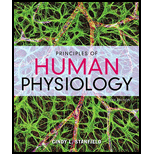
Concept explainers
Muscle fibers possess the ability to contract and relax. Sarcomeres are the fundamental units of these muscle fibers that contain myosin protein. Cross-bridges are found where the heads of myosin dimer molecules overlap forming a bridge between thick and thin filaments of myofibrils.
Answer to Problem 1E
Correct answer:
The correct answer is option (c).
Explanation of Solution
Explanation/justification for the correct answer:
Contraction of muscle fibers is powered by ATP. Cross-bridge cycling is an important feature of consideration here. When myosin head attaches to actin cross-bridges are formed. The myosin continues to attach to ADP and inorganic phosphate (Pi) in a relaxed state. The release of Pi triggers pulling of actin and results in a power stroke of contraction. So, when the muscle cell is relaxed and intracellular ATP levels are normal, a cross-bridge will remain in the high energy form with ADP and Pi bound to it. So, the correct answer is option (c).
Explanation for the incorrect answer:
Option (a) states ‘bound to actin and in lower energy form.’ Cross-bridges are formed when myosin attaches to actin in a high energy form. So, this is an incorrect option.
Option (b) states ‘bound to actin and in higher energy form.’ Cross-bridges are formed when myosin attaches to actin in a high energy form. Cross-bridges are not directly bound to actin filaments. So, this is an incorrect answer.
Option (c) states ‘in high energy form with ATP bound to it.’ The high energy form of myosin is formed when it is attached to ADP and Pi, not ATP. Hence, this option is incorrect.
Option (d) states ‘in low energy form with nothing bound to it.’ Myosin filaments are bound to ADP and Pi in a high energy form when cross-bridges are formed in a relaxed state of muscle cells. So, this option is incorrect.
Among the given options, option (c) is the correct choice. When the muscle cell is relaxed and intracellular ATP levels are normal, a cross-bridge will remain in the high energy form with ADP and Pi bound to it.
Want to see more full solutions like this?
Chapter 12 Solutions
Principles of Human Physiology Plus Mastering A&P with Pearson eText - Access Card Package (6th Edition)
 Human Anatomy & Physiology (11th Edition)BiologyISBN:9780134580999Author:Elaine N. Marieb, Katja N. HoehnPublisher:PEARSON
Human Anatomy & Physiology (11th Edition)BiologyISBN:9780134580999Author:Elaine N. Marieb, Katja N. HoehnPublisher:PEARSON Biology 2eBiologyISBN:9781947172517Author:Matthew Douglas, Jung Choi, Mary Ann ClarkPublisher:OpenStax
Biology 2eBiologyISBN:9781947172517Author:Matthew Douglas, Jung Choi, Mary Ann ClarkPublisher:OpenStax Anatomy & PhysiologyBiologyISBN:9781259398629Author:McKinley, Michael P., O'loughlin, Valerie Dean, Bidle, Theresa StouterPublisher:Mcgraw Hill Education,
Anatomy & PhysiologyBiologyISBN:9781259398629Author:McKinley, Michael P., O'loughlin, Valerie Dean, Bidle, Theresa StouterPublisher:Mcgraw Hill Education, Molecular Biology of the Cell (Sixth Edition)BiologyISBN:9780815344322Author:Bruce Alberts, Alexander D. Johnson, Julian Lewis, David Morgan, Martin Raff, Keith Roberts, Peter WalterPublisher:W. W. Norton & Company
Molecular Biology of the Cell (Sixth Edition)BiologyISBN:9780815344322Author:Bruce Alberts, Alexander D. Johnson, Julian Lewis, David Morgan, Martin Raff, Keith Roberts, Peter WalterPublisher:W. W. Norton & Company Laboratory Manual For Human Anatomy & PhysiologyBiologyISBN:9781260159363Author:Martin, Terry R., Prentice-craver, CynthiaPublisher:McGraw-Hill Publishing Co.
Laboratory Manual For Human Anatomy & PhysiologyBiologyISBN:9781260159363Author:Martin, Terry R., Prentice-craver, CynthiaPublisher:McGraw-Hill Publishing Co. Inquiry Into Life (16th Edition)BiologyISBN:9781260231700Author:Sylvia S. Mader, Michael WindelspechtPublisher:McGraw Hill Education
Inquiry Into Life (16th Edition)BiologyISBN:9781260231700Author:Sylvia S. Mader, Michael WindelspechtPublisher:McGraw Hill Education





